- What is Human Resource Management (HRM)?
- Importance of HRM in an Organization
- What are the key Objectives of HRM?
- What are the main functions of HRM?
- Scope of HRM in an Organization
- Role Of HRM in an Organization
- Technology Integration & Future Trends in HRM
- Career Paths In Human Resource Management
- Conclusion
- Frequently Asked Questions (FAQs)
- Simulation Training: Understanding the Concept
- Evolution of Training Methodologies
- Benefits of Simulation Training
- Implementing Simulation Training in Organizations
- Future Simulation Training Trends
- Summing Up
- Frequently Asked Questions
- What do you mean by Performance Appraisal?
- Purpose & Objective of Performance Appraisal
- Types of Performance Appraisal
- Methods of Performance Appraisal: Benefits & Drawbacks
- Understanding the Working of Performance Appraisal
- Benefits of Performance Appraisal with Examples
- Criticisms & Limitations Of Performance Appraisal
- Conclusion
- Frequently Asked Questions (FAQ)
- Job Analysis: Definition & Importance
- Job Analysis: Key Components
- Identifying The Right Moment For Job Analysis
- Navigating Job Analysis Process
- Distinguishing Job Analysis & Evaluation
- Using The Findings Of Job Analysis
- Conclusion
- Frequently Asked Questions (FAQs)
- Deciphering Training & Development
- Difference Between Training, Development & Learning
- Significance Of Training & Development In HRM
- Benefits Of Training & Development For Organizations
- Types & Methods Of Employee Training
- Building Blocks Of Training Programs
- Trends & Innovation In Employee Training
- Strategic Integration With Talent Management
- Addressing Challenges In Training & Development
- Frequently Asked Questions (FAQs)
- Understanding Strategic Human Resource Management
- Scope Of Strategic Human Resource Management
- Creating A Strategic HR Plan In 7 Steps
- Different Approaches To Strategic Human Resource Management
- Importance Of Strategic Human Resource Management
- Characteristics Of Strategic Human Resource Management
- Frequently Asked Questions (FAQs)
- What is Selection Procedure in HRM?
- Stages Of Selection Procedure In HRM
- Making Informed Decisions With Job Offers
- Onboarding Strategies For New Hires
- Best Practices In Selection Procedure
- Conclusion
- Frequently Asked Questions (FAQs)
- Definition Of Human Resource Planning
- Understanding The Essence Of Human Resource Planning
- Key Objectives & Importance Of Human Resource Planning
- Strategic Alignment Of Human Resource Planning
- Core Steps Involved In Human Resource Planning Process
- Analyzing Labor Market Dynamics
- Tools & Techniques For Human Resource Planning
- Common Challenges & Solutions In Human Resource Planning
- Future Trends Influencing Human Resource Planning
- Measuring Success & Progress In Human Resource Planning
- Frequently Asked Questions (FAQs)
- Concept & Purpose Of Job Evaluation
- Overview Of Job Evaluation Methods
- Importance Of Implementing A Job Evaluation System
- Steps To Conduct A Thorough Job Evaluation
- Selecting Appropriate Method For Job Evaluation
- Establishing Job Evaluation Committee
- Advantages & Limitations Of Job Evaluation Techniques
- Maintaining & Updating Job Evaluation Process
- Frequently Asked Questions (FAQs)
- What is Training Needs Analysis?
- Purpose of Training Needs Analysis
- What are the Types of Training Needs Analysis?
- 7 Key Steps to Conduct Training Needs Analysis
- Methods of Data Collection for TNA
- What are the Benefits of Training Needs Analysis?
- Conclusion
- Frequently Asked Questions (FAQ)
- Types of Training Methods
- On-the-Job Training Methods (Learning by Doing)
- Off-the-Job Training Methods (Structured Learning)
- Microlearning & Mobile Learning
- Peer-to-Peer & Self-Directed Learning
- Choosing The Right Method
- Traditional Vs Modern Training Techniques
- Evaluating The Different Types Of Training Methods
- The Future of Training
- Conclusion
- Frequently Asked Questions (FAQs)
- What is Job Design in HRM?
- Methods of Job Design: Key Strategies
- The Impact of Taylorism on Job Design
- Hackman and Oldham Model or the Job Characteristics Model
- Socio-Technical Systems and Job Design
- The Job Design Process: Best Practices
- Things to Keep in Mind for an Effective Job Design Process
- Conclusion
- Frequently Asked Questions (FAQs)
- What is Training?
- What is Development?
- Core Differences Between Training and Development
- Similarities Between Training and Development
- Why This Difference Matters: Strategic Implications
- Importance of Training and Development
- Common Pitfalls of Confusing Training and Development
- Integrating Training and Development for Holistic Growth
- Frequently Asked Questions (FAQs)
- Key Challenges in Human Resource Management
- Addressing HRM Challenges Globally
- Legal and Regulatory Compliance in HRM
- Enhancing Productivity in HRM
- HRM Challenges in India
- Strategic Role of HR Leaders
- Technological Advancements in HRM
- Diversity and Inclusion in the Workplace
- Conclusion
- Frequently Asked Questions
- What do You Mean by Sources of Recruitment?
- Internal Sources of Recruitment
- Advantages & Disadvantages of Internal Sources of Recruitment
- External Sources of Recruitment
- Advantages & Disadvantages of External Sources of Recruitment
- Key Differences Between Internal & External Sources of Recruitment
- Innovative Recruitment Channels in the Digital Era
- Conclusion
- Frequently Asked Questions
- Want to Source Right & Optimize Your Recruitment Process?
- What is Human Capital?
- Human Capital Theory Explained
- Human Capital and Economic Growth
- Measuring Human Capital
- Human Capital Formation
- Human Capital Management Strategies
- Role of Education in Human Capital Formation
- Critiques of Human Capital Theories
- Future of Human Capital in Business
- Conclusion
- Frequently Asked Questions
- What is Wage?
- Types of Wages
- What is Minimum Wage?
- What is EPF Wage?
- What is the Differential Wage Rate?
- What is Real Wage?
- What is a Living Wage?
- Theories of Wages
- Factors That Affect Wages
- How Are Wages Calculated? (Formula to Calculate Wage)
- Key Differences Between Wages Vs. Salary
- Conclusion
- Frequently Asked Questions (FAQs)
- Definition Of Training Evaluation
- Understanding Training Evaluation Models
- Different Types Of Training Evaluation Methods
- Importance & Benefits Of Training Evaluation
- Formative Vs Summative Training Evaluation
- Creating An Effective Training Evaluation In Simple Steps
- Strategies For Employee Training Evaluation
- CIPP & Kaufman's Models In Training Evaluation
- Measuring & Analyzing Training Outcomes
- Best Practices For Conducting Training Evaluation
- Frequently Asked Questions (FAQs)
- What is Wage and Salary Administration in HRM?
- Importance of Wage and Salary Administration
- Objectives Of Wage & Salary Administration
- Principles Of Wage & Salary Administration
- Factors Influencing Wage & Salary Levels
- Frequently Asked Questions (FAQ)
- Meaning Of HR Professional
- Role Of An HR Professional
- Essential Skills Of Successful HR Professionals
- Effective Communication In HR Professionals
- Decision-Making & Problem-Solving In HR Professionals
- Frequently Asked Questions (FAQs)
- Definition & Evolution Of HRMS
- Understanding The Core Functionalities Of HRMS
- Key Features & Components Of HRMS
- Benefits & Importance Of Implementing HRMS
- Security Measures & Data Protection In HRMS
- Role Of Artificial Intelligence In HRMS
- Choosing The Right HRMS For Your Organization
- Frequently Asked Questions (FAQs)
- Definition Of Job Characteristics Model
- Hackman And Oldham Job Characteristics Model
- Five Core Job Characteristics Model Explained
- Psychological States & Work Outcomes in JCM
- Autonomy & Role In Job Satisfaction
- Task Significance
- Impact Of Feedback On Job Performance
- Factors Influencing The JCM's Effectiveness
- Practical Implications For SEO Content Writing
- Frequently Asked Questions (FAQs)
- Definition Of Executive Compensation
- Basics Of Executive Compensation
- Key Components Of Executive Compensation
- Purpose Of Compensation Packages
- Role Of Executive Compensation
- Types & Structures Of Executive Compensation Plan
- Short, Medium & Long-Term Compensation
- Trends & Regulations
- Best Practices For Executive Compensation
- Corporate Strategy & Governance
- Controversies & Criticisms
- Frequently Asked Questions (FAQs)
- Defining Employee Relations
- Importance Of Employee Relations Management
- Strategies For Effective Employee Relations
- Role Of An Employee Relations Specialist
- Resolving Workplace Disputes & Conflicts
- Addressing Wage Concerns & Policy Clarification
- Legal Compliance & Employee Relations Management
- Frequently Asked Questions (FAQs)
- What is International Human Resource Management?
- Objectives of International HRM
- Functions of International HRM
- Models of International HRM
- Strategies For Effective IHRM Implementation
- Key Differences Between IHRM and Domestic HRM
- Challenges in International HRM
- Frequently Asked Questions (FAQs)
- Importance Of Executive Development In HRM
- Methods Of Executive Development
- Objectives Of Executive Development
- Importance & Benefits Of Individualized Development Programs
- Frequently Asked Questions (FAQs)
- Defining Personnel Management & Objectives
- Key Functions Of Personnel Management
- Roles & Duties Of A Personnel Manager
- Personnel Management Vs. HRM
- Approaches & Policies In Personnel Management
- Manpower Planning, Recruitment & Selection Processes
- Training & Development Within Personnel Management
- Analysing Current Trends In Personnel Management
- Frequently Asked Questions (FAQs)
- What do you mean by Job Evaluation?
- What Are the Importance of Job Evaluation Methods?
- Best 7 Job Evaluation Methods in HRM
- Role Of Market Pricing In Job Evaluation
- Advantages & Disadvantages Of Job Evaluation Methods
- Career Progression, Legal Considerations & Compliance
- Best Practices For Job Evaluations
- Conclusion
- Frequently Asked Questions (FAQs)
- What is Personnel Management (PM)?
- What is Human Resource Management (HRM)?
- Similarities Between Personnel Management & HR Management
- Elaboration on Key Evolutionary Shifts
- Emerging Trends in Modern Human Resource Management
- Frequently Asked Questions (FAQs)
- Introduction to Kirkpatrick Model
- Origin & Evolution of the Kirkpatrick Model
- Importance of the Kirkpatrick Model
- Implementing the Kirkpatrick Model Training Evaluation
- Measuring Reaction: The First Level of Evaluation
- Assessing Learning: The Second Level Explained
- Evaluating Behavior Change: The Third Level of Impact
- Analyzing Results: The Fourth Level of Training Effectiveness
- Balancing Limitations in the Kirkpatrick Model
- Final Remarks
- Frequently Asked Questions (FAQs)
- Exploring The Concept Of Salary
- Key Differences Between Wages And Salary
- Types Of Wages & Their Impact on Earnings
- Varieties Of Salary Structures
- Advantages Of Earning Wages
- Benefits Of Receiving A Salary
- Legal Distinctions In Wage & Salary
- Overtime Compensation In Wage & Salary
- Frequently Asked Questions (FAQs)
- Fringe Benefits Meaning & Objectives
- Examples & Types Of Fringe Benefits
- Necessity Of Fringe Benefits By Law
- Tax Implications For Various Fringe Benefits
- Valuing & Calculating Fringe Benefits
- Role Of Cafeteria Plans In Fringe Benefits
- Impact Of Fringe Benefits On Employees
- Business Impact Of Fringe Benefits
- Considerations In Offering Fringe Benefits
- Conclusion
- Frequently Asked Questions (FAQs)
- What Is HR Compliance & Importance
- Key Elements Of An HR Compliance Checklist
- Managing HR Compliance In The Workplace
- Conducting An Effective HR Compliance Audit
- Overcoming Challenges In HR Compliance
- Automation For Streamlined HR Compliance
- Best Practices For Enforcing HR Compliance
- Long-term Data Governance In HR Compliance
- Frequently Asked Questions (FAQs)
- What is Recruitment Process In HRM?
- 5 Essential Stages of Recruitment & Selection Process
- Identifying Vacancies & Crafting Effective Job Descriptions
- Job Portals, Social Media & Technology in Recruitment
- Internal Vs External Sources of Recruitment
- Strategies for effective Recruitment in HRM
- Psychometric Tests used in Recruitment
- Conclusion
- Frequently Asked Questions (FAQs)
Sources of Recruitment: Types, Advantages and Disadvantages
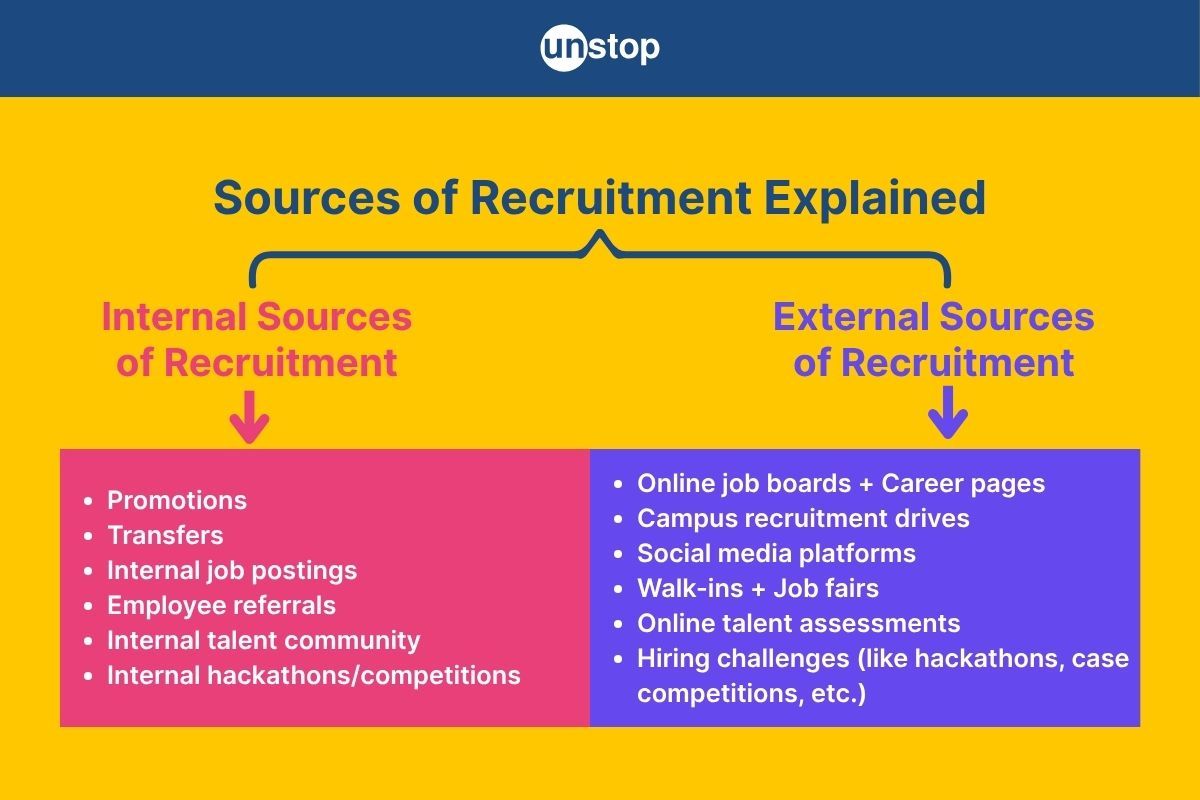
Finding the right candidate starts with choosing the right recruitment source. The two main sources of recruitment are internal and external recruitment. Both of these sources of recruitment play a crucial role in talent acquisition.
Internal sources like promotions and employee referrals offer cultural fit and faster hiring, while external sources such as job portals, recruitment agencies, and walk-ins provide access to a wider talent pool. Strategic use of these recruitment sources helps HR professionals attract skilled candidates and build stronger teams.
What do You Mean by Sources of Recruitment?
Sources of recruitment refer to the different channels or methods an organization uses to attract potential candidates for job openings. Effective recruitment sources help companies find the right talent efficiently and economically while also ensuring a strong cultural fit. To do this, organizations rely on both internal and external recruitment sources to fill vacancies based on the position type, urgency, cost, and skill requirement.
Factors to Consider When Choosing Sources of Recruitment
The choice of recruitment source depends on several factors. Let us take a look at some of the important factors involved while choosing the sources of recruitment:
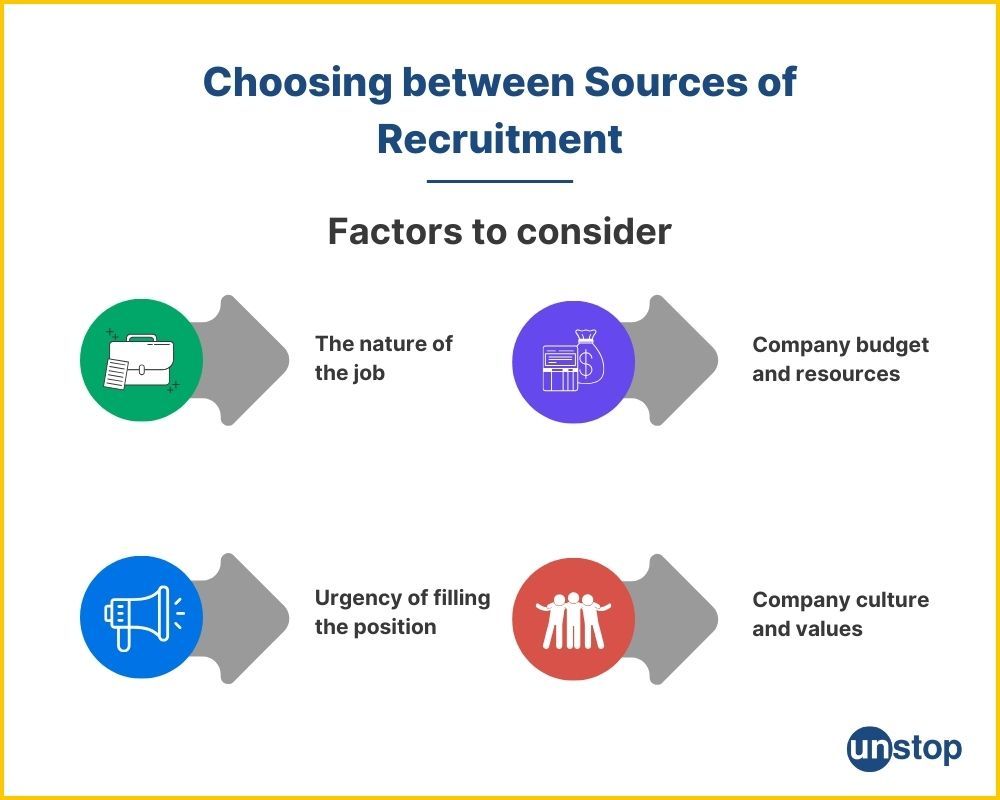
- The nature of the job: For highly specialized or senior positions, external sources like headhunters might be more effective. Entry-level or internal promotions might be suitable for lower-level roles.
- Company budget and resources: Internal sources are generally more cost-effective, while external sources like agencies might involve higher fees.
- The urgency of filling the position: External sources can generate a larger pool of candidates quickly, while internal promotions might require time for training or transition.
- Company culture and values: Organizations with a strong focus on employee development might prioritize internal promotions, while others might prefer the fresh perspectives of external talent.
Internal Sources of Recruitment
Internal source of recruitment refers to the practice of filling job vacancies within an organization by considering existing employees for the position. It involves identifying and promoting suitable candidates from within the company.
Types of Internal Sources of Recruitment
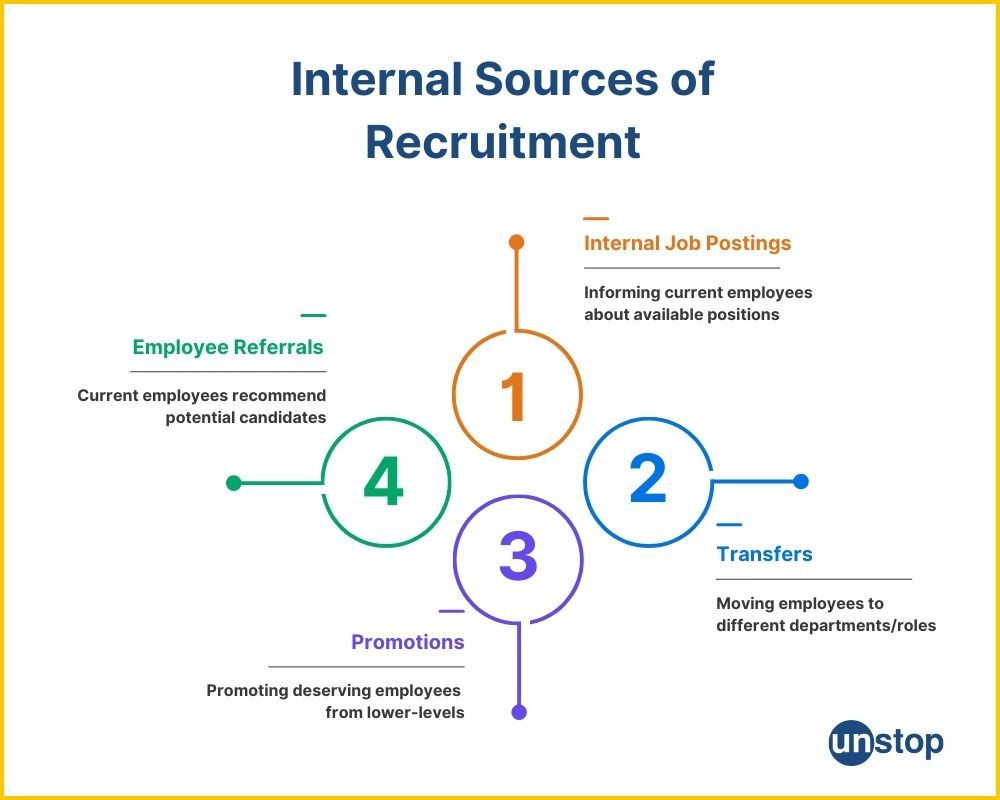
Here are some of the popular internal sources of recruitment:
- Internal job postings where current employees are informed about available positions, offering them a chance to apply before the role is opened to external candidates. This method encourages career growth and development among staff members.
- Promotions fill open positions with qualified employees from lower levels in the organization.
- Transfers involve moving employees to different departments or roles within the company based on their skill set and career aspirations.
- Employee referrals are when current employees recommend potential candidates for job openings within the company. This method leverages the networks and knowledge of existing employees to identify qualified individuals for new positions.
- Internal hackathons & engagement are events that a company organizes exclusively for its employees. These events have multi-fold benefits: they boost employee morale, foster team spirit, give an outlet for creativity & innovative thinking, and build solutions in engaging ways. When organized with the intent of internal hiring, they help employees understand if their interest lies in the new roles, and employers assess if the current employee's skill set is aligned with the new roles.
These approaches enable organizations to leverage the skills and potential of their current workforce, fostering employee development and retention.
To successfully tap into internal recruitment sources, organizations should focus on implementing clear communication channels regarding job postings, providing training programs that prepare employees for higher-level roles, and recognizing and rewarding successful internal hires, fostering a culture of growth within the organization.
Advantages & Disadvantages of Internal Sources of Recruitment
Let us now consider some of the advantages and disadvantages of the internal sources of recruitment:
Advantages of Internal Sources of Recruitment
Knowledge retention: It allows the company to retain institutional knowledge and experience. When existing employees are promoted, they already understand the company's culture, processes, and values and thus transition smoothly into the new role.
Boosts employee morale: Knowing that there are growth opportunities within the organization can motivate current employees to perform better in their roles. It also improves loyalty towards the organization.
Shorter training period: Internal recruitment often results in shorter training periods as existing employees are already familiar with the company's operations. This saves time and resources for both the employer and employee since less orientation is needed when transitioning into a new role.
Disadvantages of Internal Sources of Recruitment
Despite its benefits, internal recruitment also has some potential drawbacks:
Limited Diversity: Internal sources offer limited diversity in terms of perspectives and ideas brought into the organization. By continually promoting from within, companies may miss out on fresh insights that external candidates could bring.
Skill Gap: Not all positions can be filled internally due to a lack of specific skills or expertise among current staff members. This might necessitate additional training or development programs for existing employees before they are ready for more senior roles.
External Sources of Recruitment
External recruitment involves attracting candidates from outside the organization. This is ideal for acquiring fresh perspectives, expanding talent pools, and filling skill gaps. This also widens the talent pool and brings in skills that may not be available internally. It also allows organizations to attract candidates with diverse backgrounds and experiences, potentially bringing in new ideas and innovation.
Types of External Sources of Recruitment
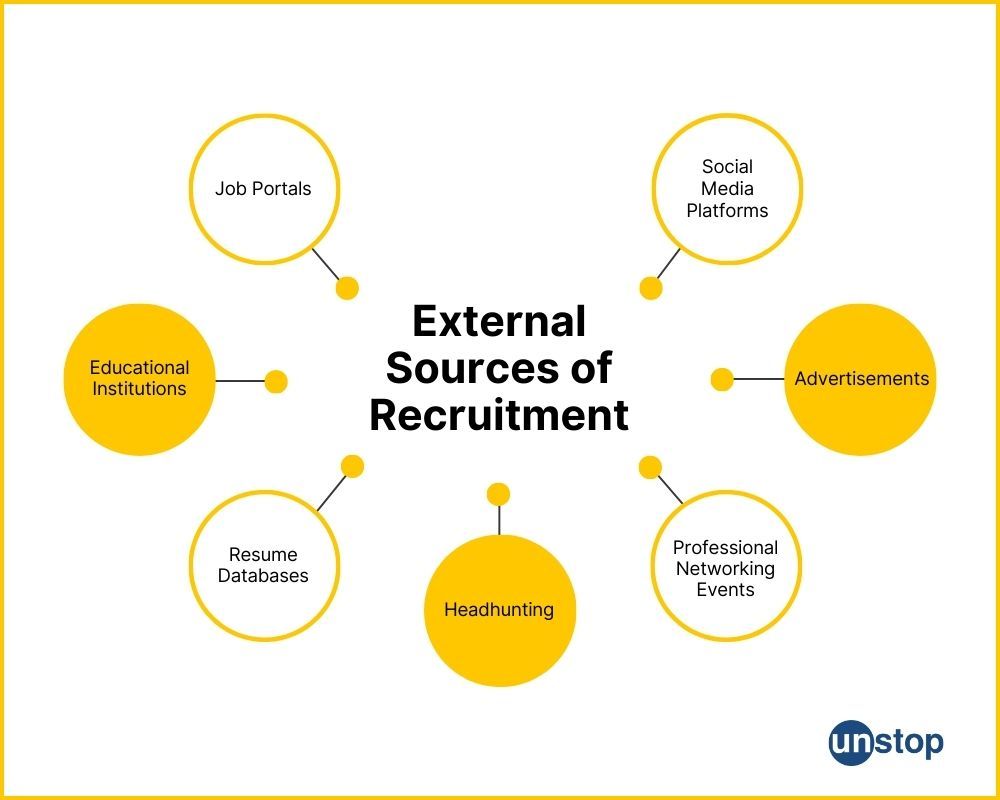
External recruitment methods, like the following, are widely used to attract potential candidates from outside the organization:
- Job portals: Online platforms that connect job seekers with potential employers, making it easier for both to find a relevant opportunity and the right candidate, respectively.
- Educational institutions: Collaborating with universities, colleges, or vocational training programs to source fresh talent. Campus hiring is a great way to tap into a talent pool of freshers.
- Resume databases: Databases of pre-registered candidates with specific skills and experience relevant to the open position.
- Headhunting: This involves proactively seeking out skilled professionals or passive candidates who might not be actively looking for new opportunities but could be enticed by an attractive offer.
- Professional networking events: Attend industry events or conferences to connect with potential candidates or post job openings within relevant professional communities.
- Advertisements: Advertisements are used as an external recruitment source to attract a wide pool of potential candidates by promoting job openings and the company's brand.
- Social media platforms: These provide a cost-effective way to advertise open positions and engage with a diverse range of candidates.
- Online talent assessments: One of the most convenient ways to assess talent for specific roles/industry/skill requirements.
- Modern online assessment platforms allow you to tailor assessments for specific requirements, ensuring the candidates are the right fit, and provide automation tools like automated candidate screening, instant AI-generated scoring, and ranking on set rubrics, to ensure fairness and eliminate bias.
- In addition, platforms like Unstop offer 360° AI-backed proctoring, which maintains the integrity of assessments, making sure you get credible candidates.
- Hackathons, case competitions, & hiring challenges: Traditional hiring methods often fail to meet the requirements of the modern hiring landscape.
- This is why many organizations have started to lean towards dynamic hiring solutions like hackathons, case study competitions, business simulations, and other hiring challenges.
- They gamify the hiring process, making it more engaging for the talent pool while allowing recruiters to assess candidates on their actual skill set and performance in real-world scenarios.
- These events also double up as ways to enhance employer brand, engage with top talent, and give them insight into the brand itself.
Advantages & Disadvantages of External Sources of Recruitment
Let us also consider some of the advantages and disadvantages of external sources of recruitment:
Advantages of External Sources of Recruitment
Fresh Perspectives: External recruitment brings fresh perspectives and new ideas to the organization. New employees may offer innovative solutions to existing problems, contributing to the company's growth. For example, a marketing firm hiring an external candidate with experience from a different industry could bring valuable insights into untapped markets.
Case example: Amazon Ads partnered with Unstop to connect with the future generation of digital marketers through the S.M.A.R.T. Challenge. This was a digital advertising challenge open to students from leading MBA colleges, divided into multiple rounds. The intent was to connect with top talent and enhace brand recall, which also helped them develop a future ready talent pipeline.
Larger talent pool: External recruitment increases the likelihood of finding individuals with specialized skills that are not currently present within the company.
Diverse Talent Pools: By casting a wider net outside of the organization, companies can attract candidates from various backgrounds, experiences, and cultures. This diversity can lead to enhanced creativity, better problem-solving abilities, and improved decision-making processes within the organization.
Case example: Walmart wanted to hire female coders to meet its diversity mandate. Unstop conceptualised a hackathon for them specifically targeting female coders from engineering colleges across India. The Walmart CodeHers Hackathon helped the organization reach a wide, diverse talent pool, and assess them on real talent not just the resume. By the end of it, they exceeded the mandate and hired top talent before their competitors.
Disadvantages of External Sources of Recruitment
Longer onboarding time: One of the disadvantages of external recruitment is the potentially longer onboarding time for new hires. Unlike internal candidates who are already familiar with the company's culture and processes, external recruits often require more time to acclimate. This can lead to delays in productivity and increased training costs as they get up to speed.
Expensive process: Recruiting externally requires conducting job postings, reviewing resumes, conducting interviews, and onboarding new hires. This process can take a significant amount of time and effort.
Pro Tip: With the rise of recruitment automation tools, you can now build company profiles & review pages, and post opporutnities in a single unified workplace. And solutions like automated candidate screening, AI-based profile ranking and matching, online talent assessments, virtual interviews with AI-bots/avataars, can help you reduce the time to hire and the cost of hire by a huge margin.
Integration challenges: There might be challenges in integrating new employees into existing teams due to unfamiliarity with colleagues and established workflows.
Key Differences Between Internal & External Sources of Recruitment
| Internal Recruitment | External Recruitment |
|---|---|
| Employees already working within the organization | Candidates from outside the organization |
| Generally low cost (no advertising or onboarding costs) | Higher costs due to ads, agency fees, and onboarding expenses |
| Faster, as candidates are readily available | Slower, involving longer screening and selection processes |
| High familiarity with company policies and culture | Low familiarity – needs time to adapt to the organization |
| Limited to existing employees | Wider pool with fresh perspectives and varied experiences |
Also read: Types of Sourcing In Recruitment: A Comprehensive Guide For Modern Recruiters
Innovative Recruitment Channels in the Digital Era
Let’s also explore how rapidly evolving digital recruitment channels are reshaping the hiring landscape:
AI-Powered Tools
Innovative sources of recruitment in the digital era include AI-powered tools for candidate sourcing, automated screening & matching, recruitment workflow automation, customizable online assessments, virtual interviews, and employer branding. These tools can efficiently analyze resumes, predict job fit, and even conduct initial interviews.
Virtual Job Fairs
Virtual job fairs are another emerging recruitment channel that allows employers to connect with a large number of potential candidates online. This approach offers convenience for both recruiters and job seekers by eliminating geographical barriers and reducing logistical costs associated with traditional career fairs.
Video Interviews & Online Assessments
Utilizing video interviews and online assessments is beneficial in the hiring process as it saves time, reduces scheduling conflicts, and provides a more comprehensive view of candidates' qualifications. Employers can evaluate candidates' communication skills, professionalism, and cultural fit through pre-recorded or live virtual interviews.
Ultimately, a strategic combination of internal and external recruitment, complemented by modern approaches, empowers companies to build robust, dynamic teams that fuel their growth.
Conclusion
Understanding the sources of recruitment is essential for building a strong workforce. Internal sources foster growth and loyalty, while external sources bring in diversity and fresh perspectives. By leveraging a mix of both—aligned with modern trends like AI tools and social hiring—organizations can improve hiring efficiency, reduce costs, and stay competitive in today’s evolving job market.
Time For A Short Quiz
Frequently Asked Questions
1. What are the main sources of recruitment?
Recruitment sources can be categorized into internal and external channels. Internal sources include promotions and employee referrals, while external sources encompass job portals, social media platforms, and recruitment agencies.
2. How does internal recruitment differ from external recruitment?
Internal recruitment involves considering existing employees for open positions within the organization. External recruitment, on the other hand, focuses on attracting candidates from outside the company to fill vacant roles.
3. What are the advantages of internal recruitment?
Internal recruitment promotes employee morale by recognizing and rewarding talent from within. It also reduces hiring costs, shortens onboarding time, and ensures a good cultural fit with existing team members.
4. Are there any drawbacks to external recruitment?
External recruiting may require more resources compared to internal methods. It could lead to longer integration periods for new hires as they familiarize themselves with the company's culture and processes.
5. Which innovative channels are utilized in the digital era recruiting?
Innovative digital channels include leveraging social media platforms like LinkedIn for targeted candidate searches, utilizing AI-driven applicant tracking systems for efficient filtering of applicants' resumes, and implementing virtual career fairs or online networking events.
Want to Source Right & Optimize Your Recruitment Process?
Explore the best recruitment automation solutions with built-in smart ATS by Unstop and its sourcing tools to custom build your recruitment process to meet your organisational goals. You can also reach out to use at coffee@unstop.com for any queries or to get a demo.
Suggested Reads:
I’m a reader first and a writer second, constantly diving into the world of content. If I’m not writing or reading, I like watching movies and dreaming of a life by the beach.
Login to continue reading
And access exclusive content, personalized recommendations, and career-boosting opportunities.
Subscribe
to our newsletter
Blogs you need to hog!
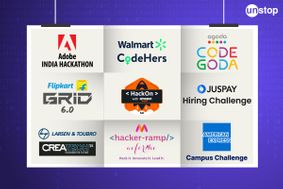
Organize Hackathons: The Ultimate Playbook With Past Case Studies

What is Campus Recruitment? How To Tap The Untapped Talent?

Lateral Hiring: A Complete Guide To The Process, Its Benefits, Challenges & Best Practices
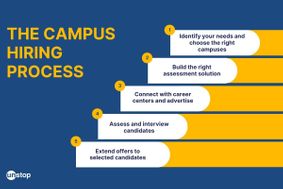








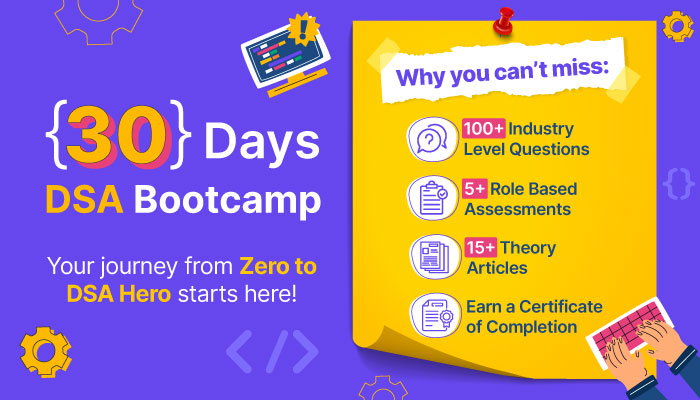



Comments
Add comment